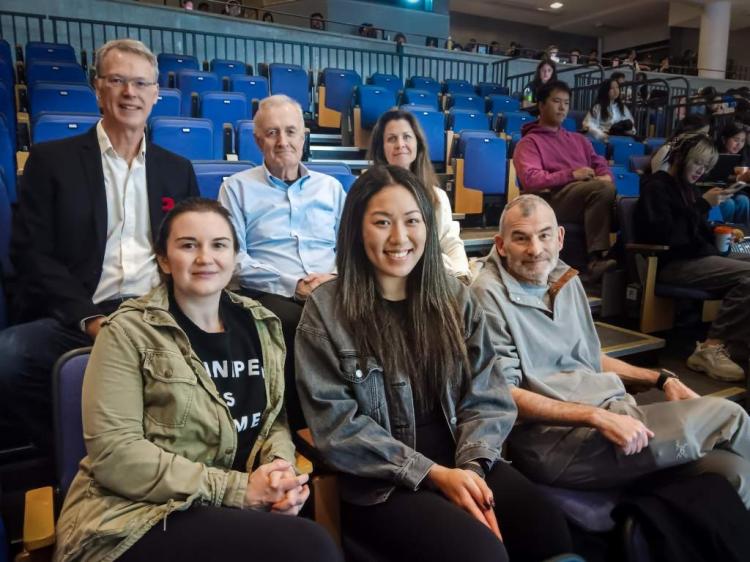OCAD U program is enriching surgeons' understanding of how the creativity process can apply to the operating room and can improve patient care
Is there room for creativity in medicine? Nine University of Toronto surgeons are stepping out of the operating room and into the art studio to find out.
A new program, Fostering Your Creativity, offered by OCAD U's School of Continuing Studies and guided by OCAD U instructors and technicians, offers participants insights into creativity, technique and problem-solving. This initiative was supported and funded by the Department of Surgery at the University of Toronto.

Dr. John Semple (top centre) with University of Toronto surgeons at OCAD U
The nine-month program, which offers surgeons an opportunity to audit a curated selection of art history, theory and studio courses, aims to deepen surgeons' understanding of how creativity can inspire innovative solutions to the human-centered challenges they face each day.
From drawing and photography to woodworking and mould-making, the surgeons will blend creativity with expertise to elevate their precision and artistry in the operating room.
The interdisciplinary program was developed in collaboration with Dr. Charles Reeve, Associate Dean, Faculty of Arts and Science, Dr. Caroline Langill, OCAD U's Vice-President, Academic and Provost, and Dr. John Semple, Head, Division of Plastic Surgery, Women's College Hospital and Professor, Department of Surgery, University of Toronto.
A surgeon and artist, Dr. Semple is recognized internationally as a clinical leader in breast reconstruction. He trained in art at the Ontario College of Art (OCA), now OCAD U, and in medical illustration at the University of Toronto. After receiving his MD degree at McMaster University and his surgical training at the University of Toronto, he founded the Division of Plastic Surgery at Women's College Hospital and has held the positions of Surgeon in Chief and Research Chair at the Canadian Breast Cancer Foundation.
"Many of the techniques I learned at OCA in drawing and painting, I use every day in the operating room and when I'm painting, I use a lot of the things that I was taught as a surgeon," says Dr. Semple. "Both in surgery and in art, we think with our hands. Whether you're holding a scalpel or paintbrush, it's all about how accurate your render and how much control you have."
"In surgery we are always trying to improve outcomes and there is always room for improvisation," adds Dr. Semple. "I believe that this type of experiential learning in art for surgeons will foster creativity and improvisation in their research and clinical practice."
For vascular surgeon-scientist Dr. Kathryn Howe, studying at OCAD U offers an opportunity to explore an aspect of learning "not well cultivated by a science or medical degree."
"I believe that my experience at OCAD U will elevate the scientific questions I ask in the laboratory and the approach I have with my fellow humans, who happen to be my patients," says Dr. Howe. "Creativity is at the root of human experience and having an orthogonal approach to understanding our fellow humans, their suffering and compassionately caring for one another is crucial."
Participants will learn about the histories and theories of art and design, then apply them in their observational, technical and material skills.
"OCAD U is excited to host this unique course of study for surgeons from the Department of Surgery, Temerty Faculty of Medicine at the University of Toronto," says Dr. Caroline Langill. "Bringing art thinking, and making', to doctors will foster creativity and demonstrate that engaging in visual art can teach them to see, and possibly practice medicine differently."
"We have been very fortunate to partner on this project with honorary doctorate recipient and OCA alum Dr. John Semple," adds Dr. Langill. "His enthusiasm for OCAD U's curriculum and pedagogy has informed this project and has been a driving force in seeing it realized."
For plastic surgery resident Dr. Emma Avery, the program provides an opportunity to "enhance mindfulness, attention to detail and collaborative practice."
"It's exciting to be in class with art students, most of whom are younger than myself, who are full of energy and creativity," says Dr. Avery. "I believe that maintaining a creative practice outside of one's job will only enhance their problem solving, teamwork, and imagination. I also believe that having a connection to art and humanities reminds physicians of the importance of patient-relationships and inculcating a positive work environment."
The program will culminate in an exhibition at OCAD U next spring, showcasing the connections between participants' surgical experiences and their creative work.










